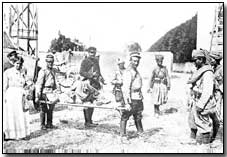Primary Documents - General German Statement on the Second Battle of the Marne, 31 July 1918
 The
Second Battle of the Marne -
which ran from 15 July to 4 August 1918 - was intended as Germany's final
major attempt at breakthrough on the Western Front prior to the arrival of
ever-increasing U.S. troops on the battlefield.
The
Second Battle of the Marne -
which ran from 15 July to 4 August 1918 - was intended as Germany's final
major attempt at breakthrough on the Western Front prior to the arrival of
ever-increasing U.S. troops on the battlefield.
In the event the battle proved a significant Allied victory. Once it became clear that the Germans had not only failed in their aim to win the war in the offensive, but had in fact lost ground, a number of German commanders, including Crown Prince Wilhelm, believed the war was lost.
Reproduced below is the text of a semi-official statement issued by Georg Wegener on the outcome of fighting at the Marne, published in Germany on 31 July 1918.
Click here to read General Gouraud's appeal to his forces at the onset of the battle. Click here to read an extract from U.S. Commander-in-Chief John J Pershing's official report summarising U.S. participation in the battle. Click here to read a German memoir focusing on the events of 15 July. Click here to read Pershing's Special Order of the Day, dated 27 August, in which he praised the role played by his forces. Click here to read another semi-official German press statement published in August 1918 on the outcome of fighting at the Marne. Click here and here to read contrasting statements regarding the effectiveness of the Allied counterattacks, issued by chief German strategist Erich Ludendorff. Click here to read the official address given by French General Charles Mangin on 7 August 1915, directed to U.S. First and Second servicemen who, assisting Mangin's French Tenth Army, participated in the Allied counter-attacks launched on 18 August. Click here to read the view later given by Mangin concerning the turning point of the Allied counterattack at the Marne. Click here to read the official address given by French Sixth Army General Jean Degoutte to French and U.S. troops towards the close of the battle, on 9 August 1918, in which he praised the conduct of American forces. Click here to read an account by Karl Rosner of how news of the battle was received by the Kaiser.
Georg Wegener's Semi-official Press Statement, 31 July 1918
The wooded country on the front of attack gave our enemies the best opportunities to assemble masses of artillery and other necessaries of attack, together with their storm troops, and to keep them concealed.
These preparations were hidden even from the most careful aerial observation. The enemy has brought the art of camouflage to the very highest development . In that he was materially helped by the fact that he possessed greater supplies of necessary materials and of labour. In this respect, as in so many others, matters are much more difficult for us.
In order to deceive us, too, he worked arduously at making defensive positions and carried out visible movements which looked like a withdrawing of troops. Despite that, we were not deceived regarding his intentions. We knew he was preparing to attack and that every wood and gully was full of troops and materials.
Only regarding the exact time of the attack we had no knowledge. We could accept the belief, however, that as our offensive was to take place further to the east its effect would be to make the enemy renounce the execution of his plans for an offensive.
That hope, however, on account of the fact that our offensive did not reach our expectations, was not realized, and the enemy could, therefore, carry out his plans at a favourable moment.
The moment of attack at dawn on July 18th was psychologically a good choice. It is only human that, with the coming of daylight, the tension which darkness produces should have been relaxed, a feeling of greater security should have taken its place, and the strained attention demanded during the night should have been involuntarily decreased. Fatigue comes over the watching troops.
The enemy had in secret built a large number of tanks of a surprisingly small type, which had the advantage of greater mobility and were easily manoeuvred. These tanks led the way, and between and behind them, morally strengthened by their presence and protection, came storm troops.
To low visibility in the early morning was added the difficulty of a complete view of the territory on which the attack took place, on account of the broken nature of the ground; the high standing corn concealed the advancing infantry masses and hid the low-built tanks. Thus our artillery could not be effective.
Such were the circumstances and the nature of the French attack.
Source: Source Records of the Great War, Vol. VI, ed. Charles F. Horne, National Alumni 1923
Flak was a term used to describe anti-aircraft fire.
- Did you know?
